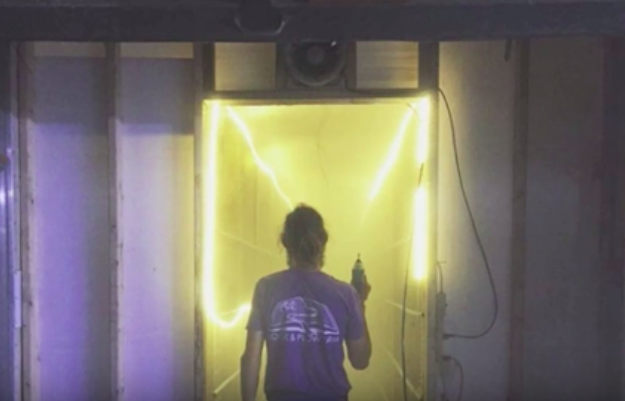This article teaches how to create a mushroom fruiting chamber so you can grow high-quality, gourmet mushrooms as a hobby or as a profession
A mushroom fruiting chamber can come in a variety of sizes, from a 2’ x 2’ tent to a 53’ trailer. Regardless of the size, there are a few things that all fruiting chambers should have in common.
A few things to consider before beginning your mushroom fruiting chamber:
- You will want a clean, controlled area to use while fruiting mushrooms.
- The area will be wet with a high humidity. A concrete floor with or near a drain is helpful.
- You want to make sure you can clean it easily. It does not need to be sterile or hyper clean, but we do clean our grow room weekly.
- A rectangular shape is preferred for a fruiting chamber because the air flow can disturb the air more evenly in this design. Otherwise there could be corners that do not receive enough airflow.
- Airflow with adequate oxygen, and not high levels of CO2, is necessary for fruiting mushrooms.
- You will need to exhaust the air out of the room.
Your mushroom fruiting chamber does not have to be high tech
In the video below we show an example of a mushroom fruiting chamber we once used. It was the second fruiting chamber we built and it was in a tobacco barn on a concrete slab. We did a very simple stick framing with wood and then put plastic over the entire chamber.
This was about a 25’ by 14’ grow room, which served as a 3-season space for growing as we did not insulate it. We were able to produce up to 200 lbs of mushrooms each week in this room!
Want to try out a grow kit in your mushroom chamber? Try our blue oyster mushroom grow kit!
A really efficient ways to develop your mushroom fruiting chamber
Have you ever toured a commercial mushroom farm? If so, consider how the structure and set up of the room is.
There are a variety of ways to set up a commercial mushroom farm. However, some ways may lead to easier methods for controlling the room. For instance, I mentioned above that it is important to be able to clean your grow space. If you are growing specialty mushrooms to eat or sell, you will need to ensure that you are growing mushrooms that do not get contaminated by any other type of fungus or bacteria. Having a clean area is a big part of this.
One way to develop a growing space that is easy to clean is by using shelves on wheels. In this type of setup the mushroom spawn bags that the fresh mushrooms grow from are placed on the shelves. Each shelf may will probably have three or more levels that can be filled with the spawn bags. These shelves can be wheeled around the concrete area, allowing the cleaning process to take place easily and efficiently. This is turn allows the mushroom farmer to focus on more important aspects of the job, like making sure the mushrooms are growing properly, harvested at the best time, and that the sales of the product continues.
The most important parameters for building a mushroom fruiting chamber
The big four:
- CO2
- Humidity
- Lighting
- Temperature
Ideally, the CO2 should be below 800 ppm, depending on strain. The humidity above 80%. There should be enough lighting in your fruiting room to see. We have our lights on enough where we could even read a book. Temperature is ideally between 60 and 65 degrees.
An example of what you could potentially grow in a 16’ x 8’ mushroom fruiting chamber
Here are some rough numbers for you on what can be achieved with some mushroom growing skills and a modestly-sized fruiting chamber.
First off, this 16’ x 8’ space could produce about 150 lbs of mushrooms per week. This room can hold 12 shelves that are 3’ long by 18” deep and 5’ tall. Each shelf can then hold 32 bags of spawn.
We can cycle in more bags, utilizing 96 bags per week. One bag fruits roughly a pound of mushrooms in its first flush. This means 96 bags will equal roughly 96 pounds of mushrooms. However, a second flush should then take place about 3 weeks after the initial flush. At this time each bag should be able to yield a half-pound of mushrooms. Adding the original 96 pounds with the 48 pounds from the second flush and we come to a total of 144 pounds of mushrooms.
At $8-$12 per pound, this is a value of $1,152 - $1,728 per week.
Do you need a professional mushroom grower as a consultant to help you get your mushroom farm under way? Reach out to us today.
Otherwise, check out our great mushroom spawn options for growing your own mushrooms at home.

